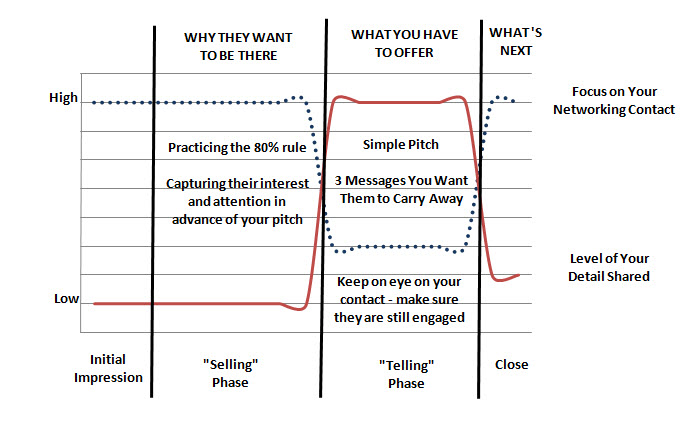Your timing of when you deliver your story makes all the difference of whether or not a meeting is successful or not. A story or pitch is only effective once you’ve fully engaged the other person.
Your timing of when you deliver your story makes all the difference of whether or not a meeting is successful or not. A story or pitch is only effective once you’ve fully engaged the other person.
WHY THEY WANT TO BE THERE
“Interested, but need to be engaged” is what I call people who have agreed to network with you. They agreed to network because of a mutual connection or desire to help, so they are interested.
You want them engaged from the start; therefore you must begin the meeting by showing them why they want to be there. We all have self-interest and desire to be appreciated. We also know when those two elements are fulfilled; we are far more likely to engage in whatever activity lies ahead of us.
While not scientific, the chart below will illustrate where to put your attention to get the most of a meeting.

HOW TO GET THEM ENGAGED

HOW TO GET THEM ENGAGED
Let’s slice up the meeting into four sections and your objective for each section.
Initial Impression: It starts with simple professional courtesy, being on time, etc., but it continues with setting the stage by establishing why you wanted to meet, expected outcome and that you are looking to network with them.
Selling Phase: The initial impression you want to set is that there is a good meeting ahead, which gets their interest. Now you want to stoke that interest by beginning with them. The best way to do this is use the 80% rule (80% of networking should be focused on other person - click on the link for tool). By doing homework beforehand and asking question during the meeting, you will likely be able to offer them help through connections or insight. During this time you do not focus on yourself at all.
Telling Phase: The help you offer has opened the door for you to make a very simple pitch. The pitch should be the 2-3 important messages that want your connection to remember after the meeting. To make a message about a skill or experience memorable is to accompany it with an outcome or important lesson. If someone would like to learn more about any of the 2-3 message, they will ask.
It's your pitch, but you still need to keep focused on your contact and watch their eyes and body language for signs of disinterest or lack of understanding. I learned that just because I thought a point was compelling it did not mean everyone did (even if I repeated it). I also learned to what how my questions where answered, which gave me a sense of how the other person likes to communicate - whether it was telling stories, humor and sketching on paper - I would use the same methods to explain my message. Remember if the loss of interest continues, regardless of where you are in the pitch, it’s time to move to the close.
Close: To send your contact with motivation to help, close the meeting with your follow-up actions. Most people will respond with their own actions, if they do not, it’s not a cause for worry. Once a meeting starts to finish most people begin to think about the rest of their day. You will get those thoughts to them in your follow-up e-mail.
Changing your contact from ‘interested’ to ‘engaged’ will make the world of difference in a meeting's effectiveness. Not just during, but more importantly after the meeting when most of the follow-up work really happens.
Hope this helps.
Mark

